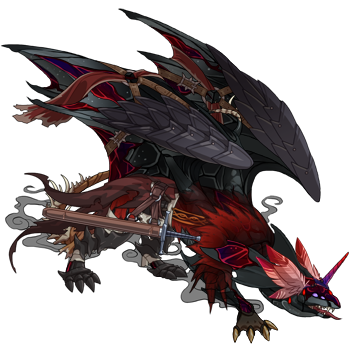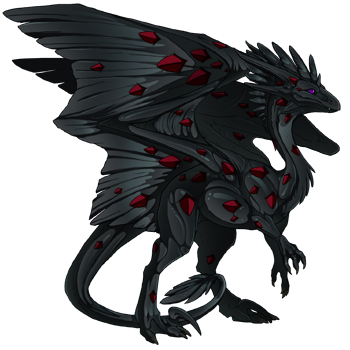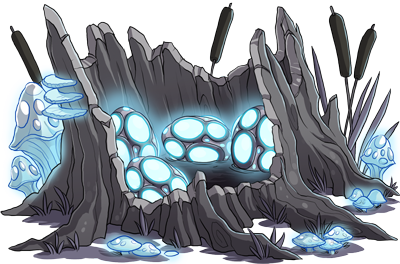Bloodletters
General Lore:
The Bloodletters know one truth: Blood is strength.
It is a lesson well known among them, these dragons whose ancestors spent their days studying the art of blood magic. They hunt everywhere in Sorneith, their dark colouration helping them blend into shadows and into the night. Predominantly nocturnal, this species have evolved into what they are today by design of their ancestors, who stumbled upon the art of blood magic centuries ago.
The blood magic artefacts and scrolls their ancestors found were fresh, and the strange writing took years to decipher. Many turned away from the study, but those that stayed reaped the rewards of this strain of new magic.
Their ancestors used the new magic to give themselves more strength, both physical and magical. Some used it to enhance their intelligence, and it was these dragons that came up with new and improved rituals and spells that harnessed the innate power in the blood of animals and other dragons.
Over time, they expanded upon the rituals and spells within the texts they had uncovered. Tests were necessary for experiments, and when no one would volunteer they had to find subjects. And of course, the best subjects to test spells and rituals designed to work on dragons were other dragons.
This was the beginning of the Hard Bloodletters. They implemented the old rituals to test the new ones, and were the first type of Bloodletter to truly harmonize the two.
The blood harvested by Bloodletters is used in many different spells and rituals that would have been forgotten over the years. These spells are used to enhance individual Bloodletters and the rituals enhance the Bloodletters as a whole. Their prey separates this species into different types: primarily Hard Bloodletters, as mentioned above, and Soft Bloodletters.
Both types store gathered blood in their bodies – the Soft type store the blood in the spines that line their back, while the Hard type store blood underneath their scales, in hardened pockets that can be drained at will. Soft and Hard Bloodletters do not have to be born to other Bloodletters - they can be made.
Scribe Bloodletters are unusual in that they don’t actually gather blood from outside sources. They are about as physically strong as the average dragon of their species, but they are also a very important part of Bloodletter rituals. Scribe are born from Scribes - they cannot be made.
There is a compulsion in all Bloodletters to use their power, and to seek out other Bloodletters to continue becoming stronger. The more they use their power, however, the stronger the compulsion.
It should be noted that the eyes of Bloodletters can give a hint to how strong an individual is. A simple guide is listed below:
It is a lesson well known among them, these dragons whose ancestors spent their days studying the art of blood magic. They hunt everywhere in Sorneith, their dark colouration helping them blend into shadows and into the night. Predominantly nocturnal, this species have evolved into what they are today by design of their ancestors, who stumbled upon the art of blood magic centuries ago.
The blood magic artefacts and scrolls their ancestors found were fresh, and the strange writing took years to decipher. Many turned away from the study, but those that stayed reaped the rewards of this strain of new magic.
Their ancestors used the new magic to give themselves more strength, both physical and magical. Some used it to enhance their intelligence, and it was these dragons that came up with new and improved rituals and spells that harnessed the innate power in the blood of animals and other dragons.
Over time, they expanded upon the rituals and spells within the texts they had uncovered. Tests were necessary for experiments, and when no one would volunteer they had to find subjects. And of course, the best subjects to test spells and rituals designed to work on dragons were other dragons.
This was the beginning of the Hard Bloodletters. They implemented the old rituals to test the new ones, and were the first type of Bloodletter to truly harmonize the two.
The blood harvested by Bloodletters is used in many different spells and rituals that would have been forgotten over the years. These spells are used to enhance individual Bloodletters and the rituals enhance the Bloodletters as a whole. Their prey separates this species into different types: primarily Hard Bloodletters, as mentioned above, and Soft Bloodletters.
Both types store gathered blood in their bodies – the Soft type store the blood in the spines that line their back, while the Hard type store blood underneath their scales, in hardened pockets that can be drained at will. Soft and Hard Bloodletters do not have to be born to other Bloodletters - they can be made.
Scribe Bloodletters are unusual in that they don’t actually gather blood from outside sources. They are about as physically strong as the average dragon of their species, but they are also a very important part of Bloodletter rituals. Scribe are born from Scribes - they cannot be made.
There is a compulsion in all Bloodletters to use their power, and to seek out other Bloodletters to continue becoming stronger. The more they use their power, however, the stronger the compulsion.
It should be noted that the eyes of Bloodletters can give a hint to how strong an individual is. A simple guide is listed below:
- Common-Uncommon-Unusual – The most common eye types, they give little to no indication of the strength of a Bloodletter.
- Rare-Dark Sclera - Less common, but gives just as little information.
- Faceted-Glowing – Bloodletters with these eye types have a strong connection to blood. You might even feel your blood responding to a call, a pull, when they lock eyes with you…
- Multi Gaze – Bloodletters with this eye type are dragons with enhanced fighting capabilities, making them extraordinarily difficult opponents. You don’t want to go to war with this dragon.
- Primal – Bloodletters with this eye type are dragons with immense elemental power. Combined with their blood powers, what horrors could this dragon bring?
Hard Bloodletters:
|
Primary Genes: Metallic/Wasp Primary Colour: Obsidian Secondary Genes: Alloy/Bee Secondary Colour: Obsidian Tertiary Genes: Opal/Scales/Veined Tertiary Colours: Blood/Sanguine/Garnet/Crimson/Brick/Clay Level Requirement: Level 15+ |
|

Lore:
These Bloodletters prey on other dragons, using their enhanced strength and speed to render their target unable to fight back. Inexperienced Bloodletters will inevitably kill their prey, but seasoned Bloodletters know to bring back their prey to the lair for further blooding.
Hard Bloodletters usually travel in trios when on a hunt. The group is made up of a mix of species, usually one Skydancer to two more physical fighters.
Thanks to their innate ability to sense the disposition of other dragons and magical energy, Skydancer Bloodletters call the shots. They decide the target, and they decide how the hunt will go.
Because their prey is other dragons, Hard Bloodletters are either incredibly clever, or incredibly talented at fighting. Hard Bloodletters train a lot with each other, always trying to learn something new or teach others a trick that will ensure a kill. Because they work in groups, Hard Bloodletters are actually the most social of the Bloodletter groups.
The tertiary colour of this species indicates how well they will adapt to new rituals and spells. The brighter the colour, the more likely the dragon is to get sick for a period of time while their body adjusts to the changes. However, the changes will be more pronounced on these individuals than on individuals with a lighter colour, who will have little to no side effects from the new spells and rituals.
Because Hard Bloodletters must be able to adapt to fighting other dragons, there is no set builds for coli.
As mentioned above, Hard Bloodletters can be made. This requires the dragon - usually a Soft but not always - to undergo three trials. They may only fail one trial.
The first trial is the Blood Trial. This is the most notorious of the three trials, and the one most likely to be failed. Seasoned Hard Bloodletters, usually those considered the strongest, fight with aspiring Hard Bloodletters for a single night. The Bloodletter who has collected the most blood at the end of the night is deemed the winner.
The second trial is the Combat Trial. Once again, seasoned Hard Bloodletters fight against the aspiring Hard Bloodletter in a fight that is simply designed to see who can dish out the most damage. The loser is the dragon to concede first, or who is most badly hurt at the end of the night.
Oftentimes, the aspiring Hard Bloodletter is successful at this trial - not because the aspiring Hard Bloodletter is stronger, but because Hard Bloodletters are so successful because they work in groups.
The last trial is held two nights after the initial two trials. This is the Last Trial - because this trial is a fight to the death between aspiring Hard Bloodletters. The winner is welcomed into the Hard Bloodletters, while the loser...
Hard Bloodletters usually travel in trios when on a hunt. The group is made up of a mix of species, usually one Skydancer to two more physical fighters.
Thanks to their innate ability to sense the disposition of other dragons and magical energy, Skydancer Bloodletters call the shots. They decide the target, and they decide how the hunt will go.
Because their prey is other dragons, Hard Bloodletters are either incredibly clever, or incredibly talented at fighting. Hard Bloodletters train a lot with each other, always trying to learn something new or teach others a trick that will ensure a kill. Because they work in groups, Hard Bloodletters are actually the most social of the Bloodletter groups.
The tertiary colour of this species indicates how well they will adapt to new rituals and spells. The brighter the colour, the more likely the dragon is to get sick for a period of time while their body adjusts to the changes. However, the changes will be more pronounced on these individuals than on individuals with a lighter colour, who will have little to no side effects from the new spells and rituals.
Because Hard Bloodletters must be able to adapt to fighting other dragons, there is no set builds for coli.
As mentioned above, Hard Bloodletters can be made. This requires the dragon - usually a Soft but not always - to undergo three trials. They may only fail one trial.
The first trial is the Blood Trial. This is the most notorious of the three trials, and the one most likely to be failed. Seasoned Hard Bloodletters, usually those considered the strongest, fight with aspiring Hard Bloodletters for a single night. The Bloodletter who has collected the most blood at the end of the night is deemed the winner.
The second trial is the Combat Trial. Once again, seasoned Hard Bloodletters fight against the aspiring Hard Bloodletter in a fight that is simply designed to see who can dish out the most damage. The loser is the dragon to concede first, or who is most badly hurt at the end of the night.
Oftentimes, the aspiring Hard Bloodletter is successful at this trial - not because the aspiring Hard Bloodletter is stronger, but because Hard Bloodletters are so successful because they work in groups.
The last trial is held two nights after the initial two trials. This is the Last Trial - because this trial is a fight to the death between aspiring Hard Bloodletters. The winner is welcomed into the Hard Bloodletters, while the loser...
Soft Bloodletters:
|
Primary Genes: Lionfish/Bar/Giraffe Primary Colour: Obsidian Secondary Genes: Noxtide/Morph Secondary Colour: Obsidian Tertiary Gene: Spines Tertiary Colours: Blood/Sanguine/Garnet/Crimson/Brick/Clay |
|

Lore:
These Bloodletters prey on all manner of animals and creatures except for other dragons. Whether because of a personal choice or inability, these Bloodletters are generally more than happy to stick to the easier prey.
Unlike the Hard Bloodletters, Soft Bloodletters are quite happy to solo their hunt. Their prey is generally not very hard to kill, unless they go after Beastclans. If that’s the case, Soft Bloodletters will sometimes swarm a Beastclan camp. In this situation, they will usually fall into following the dragon present with the brightest spines or the Noxtide or Lionfish genes because they are the most visible.
Since the majority of Soft Bloodletter prey is much easier to hunt than other dragons, Soft Bloodletters do not generally have as much combat experience and expertise.
While it isn’t exactly frowned upon, many other Bloodletters have reported that Soft Bloodletters seem to view their duty as something of a game. Some Soft Bloodletters participate in monthly competitions, the prize of which is fairly straight forward - the winner has a chance to become a Hard Bloodletter, or volunteer someone else to do it.
Because of the low chance of becoming a Hard Bloodletter, Soft Bloodletters have been known to choose another who they have had disagreements with or who they don't particularly like.
The tertiary colour in this type of Bloodletter is fairly important. This is because the brighter variations of red are linked to how well Soft Bloodletters react to certain spells and rituals. There is nothing to say that a Soft Bloodletter with clay tert can’t collect as much blood as an identical dragon with crimson tert, but clay tert Soft Bloodletters generally have issues with spells and rituals designed to increase how much blood they can hold.
Unlike the Hard Bloodletters, Soft Bloodletters are quite happy to solo their hunt. Their prey is generally not very hard to kill, unless they go after Beastclans. If that’s the case, Soft Bloodletters will sometimes swarm a Beastclan camp. In this situation, they will usually fall into following the dragon present with the brightest spines or the Noxtide or Lionfish genes because they are the most visible.
Since the majority of Soft Bloodletter prey is much easier to hunt than other dragons, Soft Bloodletters do not generally have as much combat experience and expertise.
While it isn’t exactly frowned upon, many other Bloodletters have reported that Soft Bloodletters seem to view their duty as something of a game. Some Soft Bloodletters participate in monthly competitions, the prize of which is fairly straight forward - the winner has a chance to become a Hard Bloodletter, or volunteer someone else to do it.
Because of the low chance of becoming a Hard Bloodletter, Soft Bloodletters have been known to choose another who they have had disagreements with or who they don't particularly like.
The tertiary colour in this type of Bloodletter is fairly important. This is because the brighter variations of red are linked to how well Soft Bloodletters react to certain spells and rituals. There is nothing to say that a Soft Bloodletter with clay tert can’t collect as much blood as an identical dragon with crimson tert, but clay tert Soft Bloodletters generally have issues with spells and rituals designed to increase how much blood they can hold.
Scribe Bloodletters:
|
Primary Genes: Metallic/Wasp/Bar Primary Colour: Obsidian Secondary Genes: Alloy/Bee/Morph Secondary Colour: Obsidian Tertiary Gene: Runes Tertiary Colours: Blood/Sanguine/Garnet/Crimson/Brick/Clay |
|

Lore:
Several of the ancestors carved portions of the scripts they found into their body. Why exactly they did this is unknown to all but other Scribe Bloodletters. This self-mutilation was passed onto their offspring (without the actual act of mutilation), and thus today’s Scribe Bloodletters are directly descended from the ancestors.
The runes etched into their bodies also help to contain the bloodletting power within their bodies.
Scribe Bloodletters are a highly secretive sect of Bloodletters. They rarely leave the lair, and are almost obsessed with the books and scrolls in their care, scouring both the translated copies and the originals for something that has been missed. They are also solely responsible for creating new rituals and spells.
Scribe Bloodletters can offer their own blood to spells and rituals, an act that is not allowed to be done by any of the other groups. This is where the colour of the tertiary really comes into play.
The brighter the red of the runes etched into their scales, the more rituals the Scribe can donate too. It is also an indication of how likely a new ritual or spell that the individual comes up with is to work properly, with no unintended side effects.
The creation of spells and rituals is almost a sacred thing to Scribes. To create the magic for the spells to take hold and the rituals to be complete, Scribes have to put a part of themselves into the creation of their spells and rituals.
The runes etched into their bodies also help to contain the bloodletting power within their bodies.
Scribe Bloodletters are a highly secretive sect of Bloodletters. They rarely leave the lair, and are almost obsessed with the books and scrolls in their care, scouring both the translated copies and the originals for something that has been missed. They are also solely responsible for creating new rituals and spells.
Scribe Bloodletters can offer their own blood to spells and rituals, an act that is not allowed to be done by any of the other groups. This is where the colour of the tertiary really comes into play.
The brighter the red of the runes etched into their scales, the more rituals the Scribe can donate too. It is also an indication of how likely a new ritual or spell that the individual comes up with is to work properly, with no unintended side effects.
The creation of spells and rituals is almost a sacred thing to Scribes. To create the magic for the spells to take hold and the rituals to be complete, Scribes have to put a part of themselves into the creation of their spells and rituals.
Scattered Bloodletters:
|
Primary Gene: Giraffe
Primary Colours: Blood/Sanguine/Garnet/Crimson/Brick/Clay Secondary Gene: Alloy Secondary Colour: Obsidian Tertiary Gene: Crackle Tertiary Colour: Obsidian |
|

Lore:
Perhaps the rarest Bloodletter, the Scattered Bloodletter is a Bloodletter that combines characteristics of Hard and Soft Bloodletters with a little something extra.
Exactly how these Bloodletters came to be is unclear, but they are not a new addition to the Bloodletter subspecies. Scribe records show them popping up every now and then, especially when the bloodletting is good. Because of this, Scattered Bloodletters are usually considered good omens.
Despite this, or perhaps because of this, Scattered Bloodletters generally come of as rather standoffish. They are extremely loyal individuals, however, and will sometimes choose a Scribe to follow and serve. Once the choice is made there is little that will dissuade a Scattered Bloodletter that the Scribe they follow is anything but perfect.
Scattered Bloodletters generally can’t produce true Bloodletter offspring. For the most part, Scattered Bloodletters are born from Scattered Bloodletters.
These Bloodletters are not affected by Scribe rituals and spells.
Exactly how these Bloodletters came to be is unclear, but they are not a new addition to the Bloodletter subspecies. Scribe records show them popping up every now and then, especially when the bloodletting is good. Because of this, Scattered Bloodletters are usually considered good omens.
Despite this, or perhaps because of this, Scattered Bloodletters generally come of as rather standoffish. They are extremely loyal individuals, however, and will sometimes choose a Scribe to follow and serve. Once the choice is made there is little that will dissuade a Scattered Bloodletter that the Scribe they follow is anything but perfect.
Scattered Bloodletters generally can’t produce true Bloodletter offspring. For the most part, Scattered Bloodletters are born from Scattered Bloodletters.
These Bloodletters are not affected by Scribe rituals and spells.
Dicot Bloodletters:
|
Primary Gene: Lionfish
Primary Colours: Obsidian Secondary Gene: Bee Secondary Colour: Obsidian Tertiary Gene: Spines/Opal Tertiary Colour: Blood/Sanguine/Garnet/Crimson..................... |
|
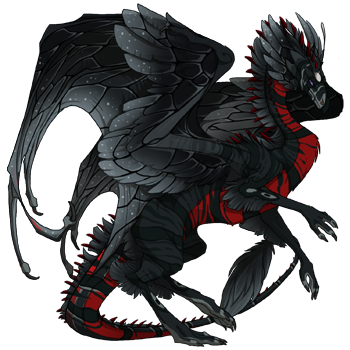
Lore:
These Bloodletters aren’t well known. They hatch rarely, since Soft and Hard Bloodletters do not commonly mate. When they do hatch, they are usually considered ‘defective’ and offered up for exaltation. If, however, these Bloodletters are allowed to live as part of the clan, they are usually fairly powerful individuals.
If they can use their true potential.
These Bloodletters usually suffer from a dichotomy that stems from their mixed heritage. They are generally viewed as unstable or extremely changeable individuals, with mercurial moods. No two Dicots find their power in the same way - where one would find their full strength in their calm, another will find their strength in their fury.
Unlike the other Bloodletters, tertiary colour does not play a role in how strong Dicots are. Their strength as Bloodletters is midway between Soft and Hard. Rituals and spells don’t affect them as much as Hard and Soft Bloodletters, but they can be the subject of rituals and spells that are designed for both types of Bloodletters.
If they can use their true potential.
These Bloodletters usually suffer from a dichotomy that stems from their mixed heritage. They are generally viewed as unstable or extremely changeable individuals, with mercurial moods. No two Dicots find their power in the same way - where one would find their full strength in their calm, another will find their strength in their fury.
Unlike the other Bloodletters, tertiary colour does not play a role in how strong Dicots are. Their strength as Bloodletters is midway between Soft and Hard. Rituals and spells don’t affect them as much as Hard and Soft Bloodletters, but they can be the subject of rituals and spells that are designed for both types of Bloodletters.
Convert Bloodletters:
|
Primary Genes: Metallic/Wasp/Bar/Giraffe
Primary Colour: Obsidian Secondary Genes: Alloy/Bee/Morph Secondary Colour: Obsidian Tertiary Genes: Scales Tertiary Colour: Clay/White..................... 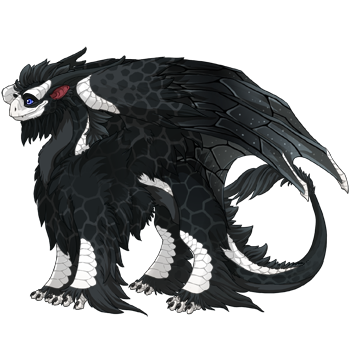
Lore:
These Bloodletters began as prey. A relatively rare occurrence, these dragons must find their place amongst the Bloodletters, since without the help of Scribe Bloodletters these Converts will ultimately be driven mad by the new compulsion to collect blood without knowing how. Although dragons are unable to change their own genes and colours, the bloodletting process changes them, resulting in Converts.
Converts with white scales are worse off than those with brick. White tert Converts cannot hold blood - instead, they constantly lose blood. For white scale Converts, gathering blood is the only thing that can keep them alive. Brick scale Converts are similar in strength to Soft Bloodletters with the same colour tert - however, the usual Bloodletter rituals and spells do not work on Converts. This means that all Converts are stuck at whatever level of power - magic, physical, and intellectual - they have when they initially awaken from being drained. Despite now belonging to the Bloodletters, no Convert can ever become a Scribe, and very few will become Hard Bloodletters. The majority of Convert Bloodletters are classed as Soft Bloodletters.
Shardflank Bloodletters:
|







